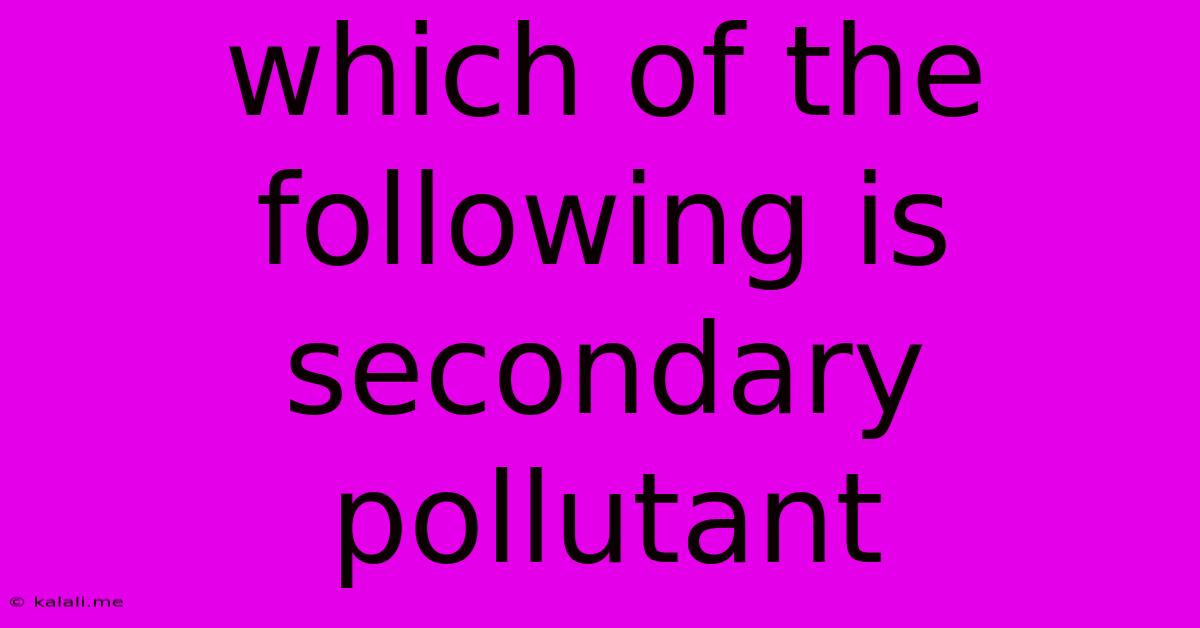Which Of The Following Is Secondary Pollutant
Kalali
Jun 13, 2025 · 3 min read

Table of Contents
Which of the Following is a Secondary Pollutant? Understanding Air Pollution
Air pollution is a significant environmental problem, impacting human health and the planet. Understanding the different types of pollutants is crucial to mitigating their effects. This article will delve into the distinction between primary and secondary pollutants, focusing on identifying which pollutants fall into the secondary category. We'll explore the formation processes and provide clear examples.
What are Primary and Secondary Pollutants?
Air pollutants are broadly classified into two categories: primary and secondary. Primary pollutants are emitted directly from a source, such as a vehicle exhaust pipe or industrial smokestack. These pollutants are released into the atmosphere in their harmful form. In contrast, secondary pollutants are not directly emitted. Instead, they form in the atmosphere through chemical reactions between primary pollutants and other atmospheric components, like sunlight and water vapor.
Identifying Secondary Pollutants:
The key to identifying a secondary pollutant lies in understanding its formation process. It's not enough to know the pollutant itself; you must know how it's created. Let's look at some common examples:
Common Examples of Secondary Pollutants:
-
Ozone (O3): This is a classic example. Ozone is a crucial component of the stratosphere, protecting us from harmful UV radiation. However, ground-level ozone is a harmful secondary pollutant. It forms through complex photochemical reactions involving nitrogen oxides (NOx) and volatile organic compounds (VOCs) in the presence of sunlight. These NOx and VOCs are primary pollutants, emitted from vehicles and industrial processes. The sunlight acts as a catalyst, driving the chemical reactions that create ozone.
-
Sulfuric Acid (H2SO4): This strong acid is formed when sulfur dioxide (SO2), a primary pollutant released from burning fossil fuels, reacts with water vapor and oxygen in the atmosphere. This reaction is often facilitated by the presence of other atmospheric particles. The resulting sulfuric acid contributes significantly to acid rain.
-
Nitric Acid (HNO3): Similar to sulfuric acid, nitric acid is a secondary pollutant formed from the reaction of nitrogen oxides (NOx), primarily nitrogen dioxide (NO2), with water vapor and oxygen. Like sulfuric acid, it contributes to acid rain and other environmental problems.
-
Peroxyacetyl Nitrate (PAN): PAN is another significant photochemical oxidant formed from reactions involving NOx and VOCs in the presence of sunlight. It's a strong irritant and contributes to smog formation. This illustrates the interconnectedness of pollutants in creating secondary pollutants.
-
Smog: Smog itself isn't a single pollutant but a complex mixture of primary and secondary pollutants. It's a visible haze that often forms in urban areas due to the accumulation of pollutants, primarily from vehicle emissions and industrial activities. Ozone, PAN, and other secondary pollutants are major components of smog.
Distinguishing Between Primary and Secondary Pollutants:
The crucial difference lies in the point of emission. Primary pollutants are emitted directly, while secondary pollutants are formed after emission of primary pollutants. Understanding this distinction is critical for developing effective pollution control strategies. Targeting only the secondary pollutants is ineffective; you must address the primary pollutants responsible for their formation.
Conclusion:
Numerous pollutants can be classified as secondary, highlighting the complex nature of air pollution. Understanding the formation pathways of these pollutants is vital for implementing effective mitigation strategies. Focusing on reducing the emissions of primary pollutants, like NOx and VOCs, is crucial to minimizing the formation of harmful secondary pollutants like ozone and acid rain. This holistic approach is essential for improving air quality and protecting human health and the environment.
Latest Posts
Latest Posts
-
How Are Trade Offs And Opportunity Costs Related
Jun 14, 2025
-
What Does The Area Under The Velocity Time Graph Represent
Jun 14, 2025
-
Which Of The Following Is An Irrational Number
Jun 14, 2025
-
Which Of The Following Statements About Activity Based Costing Is True
Jun 14, 2025
-
Caring For A Client Who Has Paraplegia
Jun 14, 2025
Related Post
Thank you for visiting our website which covers about Which Of The Following Is Secondary Pollutant . We hope the information provided has been useful to you. Feel free to contact us if you have any questions or need further assistance. See you next time and don't miss to bookmark.